Scaler 3 just a few days ago, and today I’m going to break down everything you need to know about it.
If you’re unsure, Scaler is all about helping producers and composers explore harmony, generate chord progressions, and get inspired right off rip.
Yes, even if you don’t have a background in music theory.
It can help you lock into keys, suggest chords, and even play experimental chord progressions you might never think of on your own.
Plus, it’s capable of real-time MIDI capture, AI-driven progression building, VST/AU plugin hosting, expression performance playback, and so much more.
If you’re a producer that’s interested in learning all about Scaler 3, stick with me, because I’m going to break down all its new features and functions, like:
- New AI chord suggestion tools ✓
- Upgraded modulation & clever scale detection system ✓
- Improved expression performances ✓
- All-new Keys Lock 2.0 system ✓
- VST/AU plugin hosting ✓
- A smoother multi-lane timeline ✓
- Overhauled UI and DAW sync workflow ✓
- Real-time MIDI editing, capture & routing ✓
- New genre-specific chord sets & harmonic alternatives ✓
- Enhanced/new plugin hosting capabilities ✓
- Much more about Scaler 3 ✓
By the end, you’ll know all about Scaler 3 and why it’s considered one of the most powerful tools for songwriting/composition in any music production environment.
This way, you’ll know exactly how to create inspiring new chord progressions, knock out bold harmonic structures, and play with alternative chords like an absolute boss.
Table of Contents
- What is Scaler 3 All About?
- Chord Genie: A Way Better Alternative to Scaler 3 (Dropping April 4th)
- New Features & Functions of Scaler 3
- Refined UI, Workflow Enhancements & DAW Sync
- AI Tools: Suggest Mode, Phrase Generator & Melody Lock
- Chord Creator 3.0 & Modulation Tools
- Expression Performances, Articulations & Humanization
- Keys Lock 2.0, Performance Timing & Custom Mapping
- New Sounds, Genre Packs & Preset Browsing
- Scaler+ Mode, MIDI Capture & Multi-Plugin Routing
- Bonus Tips, Tricks, and Techniques for Using Scaler 3
- Final Thoughts
What is Scaler 3 All About?
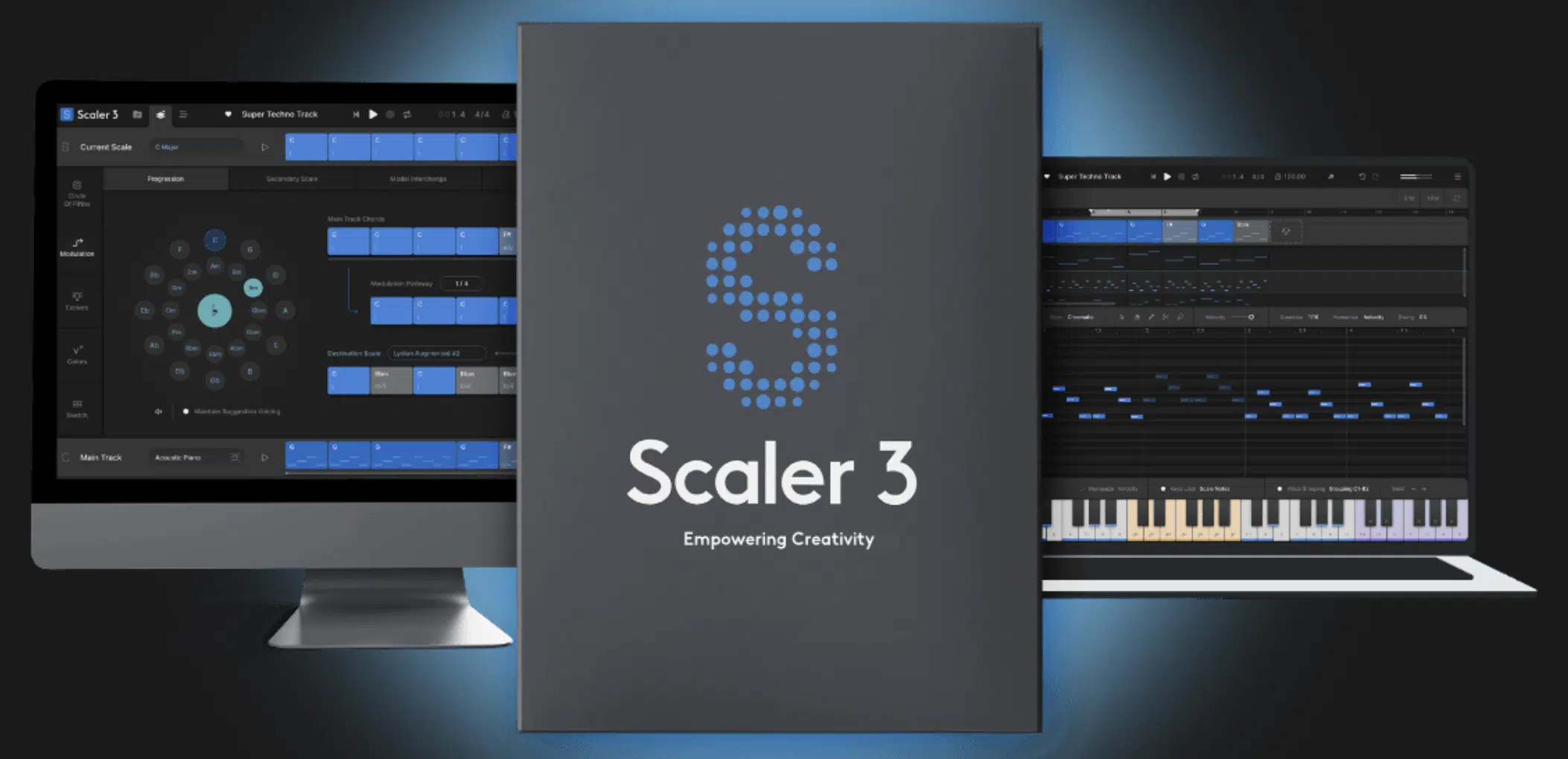
Scaler 3 is a flexible songwriting tool that allows you to lock into scales, generate chord progressions, and even suggest chords based on where you are in your arrangement.
It’s perfect for triggering one finger chords, playing with chord voicings, or diving deep into modal interchange — even if you’ve never studied music theory in your life.
The best part is how easily it integrates with your DAW or standalone app setup, giving you access to a huge bank of inspiring chord sets and the ability to play chords that fit perfectly into your current project.
Whether you’re writing for trap, R&B, house, cinematic scores, or experimenting with parallel and relative chords, Scaler adapts to your style with zero friction.
And today, I’ll be breaking everything down that’s new in Scaler 3, plus some solid tips at the end — so stay tuned.
Chord Genie: A Way Better Alternative to Scaler 3 (Dropping April 4th)
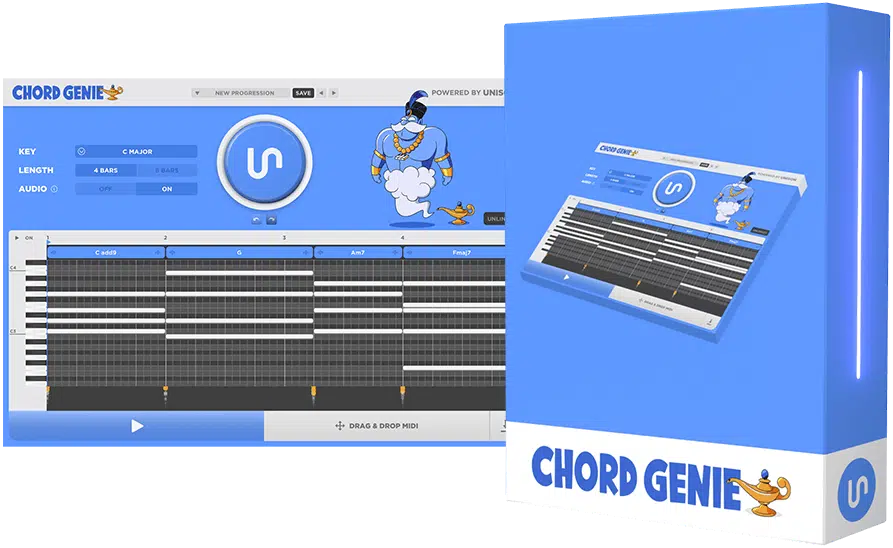
Before we break down all of Scaler 3’s new features and functions, I’ve got to tell you about Chord Genie, because if you thought Scaler 3 was impressive, just wait until you check it out.
Chord Genie instantly generates unlimited, professional-sounding chord progressions without you having to know a thing about music theory.
It’s designed to give you instant inspiration and push your creativity beyond all limits 一 helping you break through creative block or any other beat-making problems.
And the best part is, it’s as easy as 1-2-3:
- Simply select the desired scale (like F minor if you’re creating dark trap vibes, or C major for catchy pop beats).
- Click generate to instantly produce a professional-grade chord progression with perfect musicality every single time.
- Drag & drop your fresh chord progression directly into your DAW to quickly build your new legendary track around it.
You’ll instantly have the backbone of your next song, so the hardest part of starting your beat has been done for you.
And, if you’re like me, that’s the hardest part of making a beat, so it’s invaluable.
Chord Genie also includes a powerful preset saver that allows you to store your favorite chord progressions for easy access later.
It’s perfect for when you’re in the zone and any little inconvenience could destroy things.
And you don’t have to worry about wasting time on endless tweaking either.
Unlike Scaler 3, Chord Genie uses groundbreaking AI trained on thousands of proven hit-song progressions so you’ll get mind-blowing chords every time you hit generate.
It even has a built-in Circle of Fifths display, so you can even enhance your theory skills in the process (to break all the rules later).
You’ll also get access to a built-in piano roll with full editing capability, scale highlighting to avoid wrong notes and easy drag-and-drop MIDI export.
Plus, it integrates perfectly with any synth or instrument VST, so you can get as crazy as you want when it comes to some extra manipulation.
With fully royalty-free chord progressions, you can use Chord Genie for commercial projects or even create your own MIDI packs and earn some extra revenue.
It’ll make your production workflow way faster and easier, to say the least.
Even better, Chord Genie flawlessly connects to other Unison plugins like MIDI Wizard 2.0, Drum Monkey, and Bass Dragon to create fully polished tracks with zero hassle.
Combined with its fun, engaging user interface that makes music production feel exciting again, Chord Genie truly delivers unmatched results and a next-level experience.
Even Grammy-winning producers are already raving about Chord Genie (check it out below), and with endorsements like that, trust me you do NOT want to miss out.


New Features & Functions of Scaler 3
Scaler 3 brings a serious list of upgrades to the table. Some are visual, others are musical, and all of them are geared toward making your workflow faster, cleaner, and more creative. So, let’s go through each one so you know exactly how to get the most out of it.
-
Refined UI, Workflow Enhancements & DAW Sync
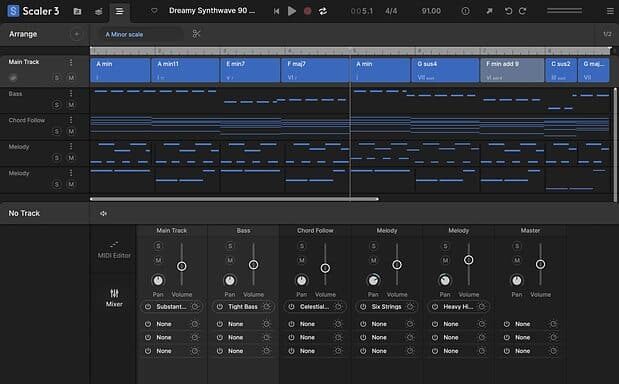
The first thing I noticed when opening up Scaler 3 was the interface because the new layout makes everything feel way easier to work with.
It’s cleaner, better organized, and just overall smoother to work with 一 you’ve got a much more modern look now, but it’s not just about looks.
Function-wise, it’s a big step up as well.
Everything is grouped better, which lets you move between scales, chord sets, performance options, and playback controls without jumping through a maze of tabs.
One of my favorite upgrades is the multi-lane timeline, which basically turns Scaler into a mini arranger.
You can now stack multiple chord tracks and performance lanes right inside Scaler 3, which makes it way easier to experiment with different chord progressions and compare variations side-by-side.
I’ve been using it to test out different main chord progressions across genres (like layering a soulful R&B progression underneath a more trap-inspired rhythm).
It’s wild how much control you get just from inside Scaler 3.
DAW sync is also way tighter now; when you hit play in my DAW, Scaler 3 locks in with no drift or any issues.
If I’ve got a pattern playing inside FL Studio or Ableton, Scaler 3 doesn’t lag.
It triggers exactly on grid, which is super important when you’re previewing chord voicings or rhythm-based expression performances.
The entire plugin just feels more reactive and integrated into the music production environment instead of floating on the side.
They also made MIDI export cleaner…
You can drag and drop editable MIDI data directly from Scaler into your piano roll, and it keeps your currently selected chords, timing, and even some humanization.
If you like layering chords with a synth stack or routing into Kontakt or your favorite third-party instrument, the workflow’s been seriously tightened up.
Overall, the new UI, timeline, and DAW integration don’t just look good, they actually make it feel more like a centerpiece in your session rather than just a plugin that throws chords at you.
Pro Tip: You can also think of Scaler 3 as a feature-rich MIDI editor, especially now that it lets you build full arrangements using its multi-lane timeline, customize velocity, and drag everything into your DAW with all timing and humanization settings preserved.
It’s like programming MIDI inside your piano roll, except smarter, more musical, and way faster when you’re sketching out harmonic ideas.
-
AI Tools: Suggest Mode, Phrase Generator & Melody Lock
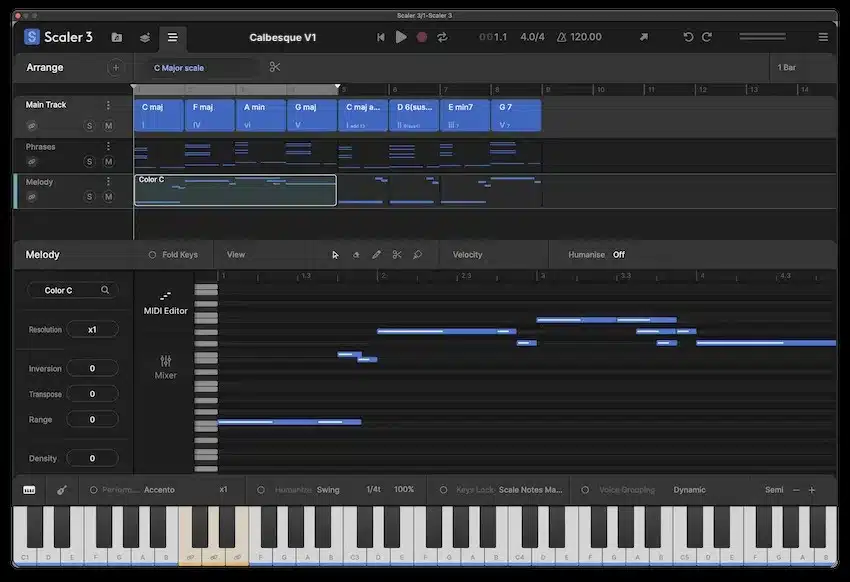
Now let’s talk about the AI tools in Scaler 3, because this is where it starts to feel like a next-gen plugin.
The new Suggest Mode is honestly a game-changer.
When you’re stuck or trying to come up with experimental chord progressions, this feature steps in and gives you ideas based on what you’ve already got loaded.
It doesn’t just suggest random chords, it looks at your main chord track, key, and the harmonic context for harmonic alternatives that actually make sense musically.
I’ve used it to find nearby chord substitutions and create smoother transitions, especially when working with modal interchange or extended harmony.
The Phrase Generator is super fun for building movement.
It creates little melodic lines and motifs that follow your chord progressions, which can be a pretty solid starting point for top-line melodies or counter melodies.
Sometimes I’ll grab a phrase it generates, throw it on a bell patch or something atmospheric, and it instantly adds texture.
And it’s not overcomplicated either 一 you simply hit generate, and you’ve got something you can tweak or bounce straight into your session, which is awesome.
Then there’s Melody Lock, which lets you lock your keyboard or MIDI input to the active dynamic scale feature or chords.
That means every note you play stays in key (or better yet, it lands on chord tones depending on your settings).
It’s perfect when you want to freestyle some melodic ideas without worrying about hitting wrong notes.
If you’re not super confident with scales or intervals, this thing gives you the safety net you need, especially when layering leads or composing in real time.
What I like about these tools is how they don’t feel like a crutch.
They actually help solve musical puzzles, especially when you’re moving between sections or trying to write a hook that fits the vibe but needs some harmonic twist.
Instead of dragging your session to a full-blown stop, these features keep things flowing and get you to the good stuff faster.
And when it comes to songwriting, this combo of tools can easily help you build chord progressions, suggest complementary chords, and play around with relative chords.
All without getting overwhelmed or losing inspiration.
It’s kind of like having a co-producer that understands music theory, but doesn’t make you feel dumb for not knowing all the rules.
-
Chord Creator 3.0 & Modulation Tools
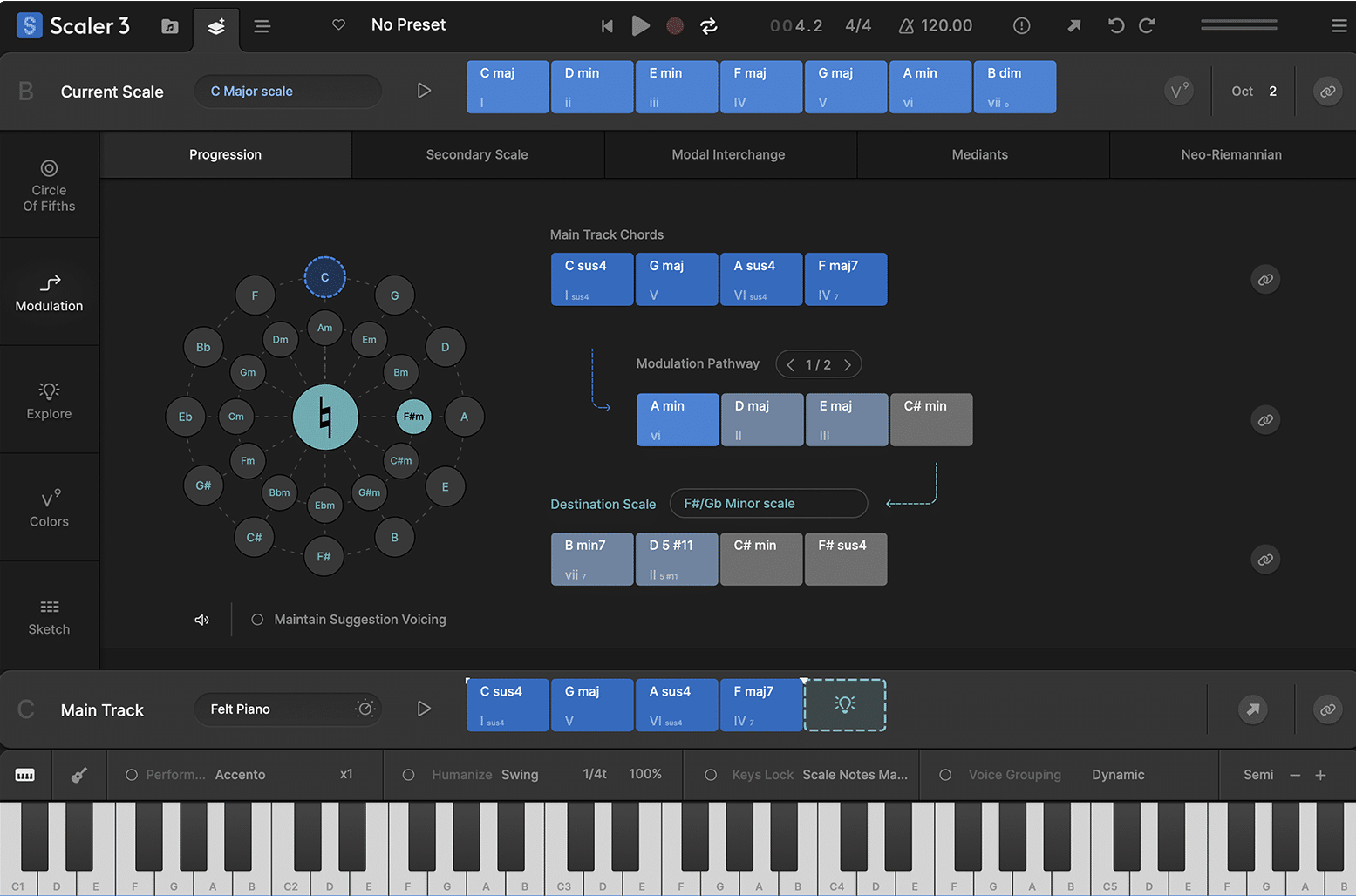
The upgraded Chord Creator 3.0 in Scaler 3 is way smarter than before in my opinion.
It has a much deeper understanding of how to build chord progressions that actually sound emotionally on point (because some plugins straight up suck at that).
Instead of just stacking triads, it now factors in:
- Voice leading
- Tension and release
- Key movement
This way you can create more bold harmonic structures without any issues.
The modulation engine has been updated too, giving you visual paths to explore new keys, find relative chords, and experiment with chord substitutions.
I know a lot of people who love it for modulating from minor to major across a chorus section, and the harmonic modifiers make that transition sound super easy.
There’s also a tool to find nearby chord substitutions, which makes it easy to swap out something basic for a more advanced voicing or add some extra flavor using parallel and relative chords.
Bottom line, if you’re someone who likes pushing harmony but doesn’t want to get stuck in theory books, this section alone makes Scaler 3 a go-to.
-
Expression Performances, Articulations & Humanization
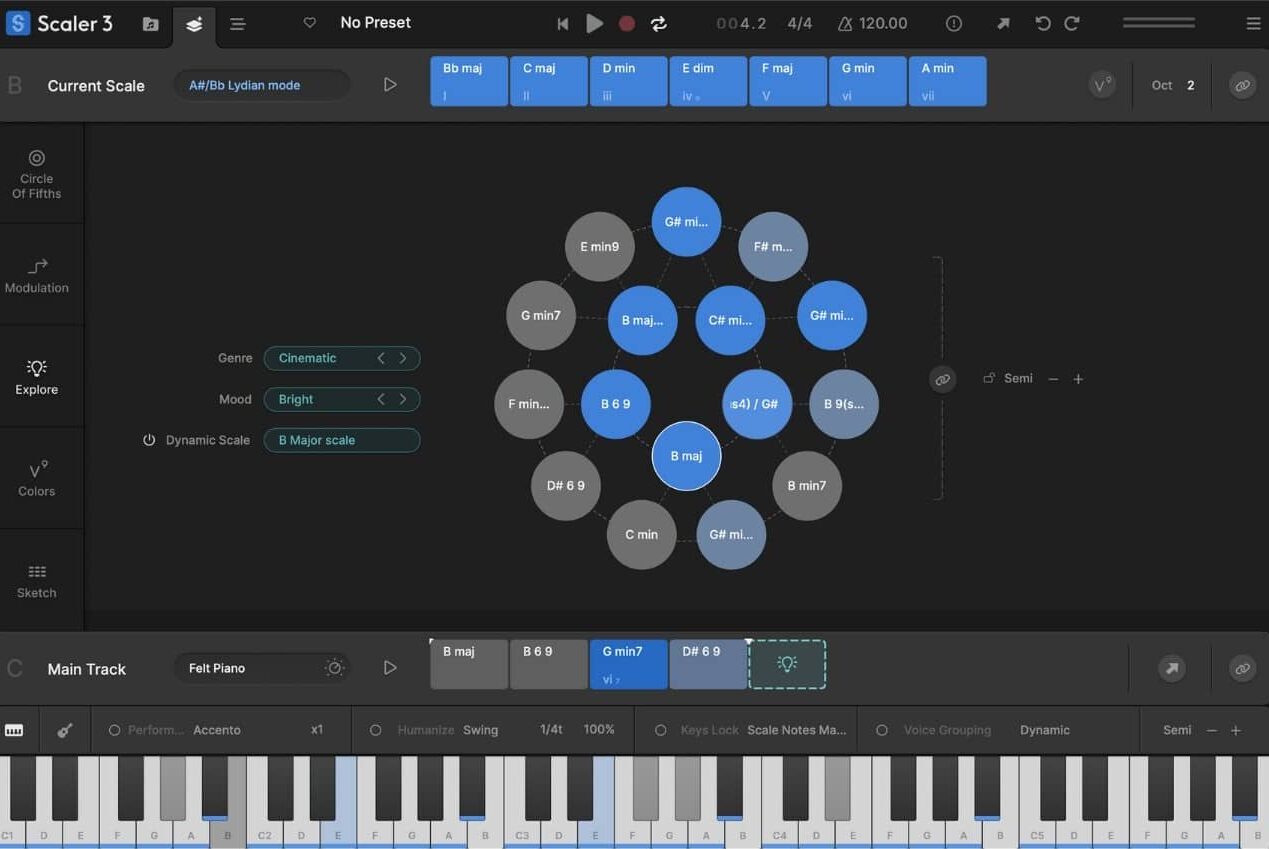
Scaler 3 now includes over 600 expression styles across different genres 一 including R&B, hip-hop, trap, drill, afrobeat, cinematic scoring, etc.
This way, you can hear your chord progressions played with that authentic feel, and they’re also full customizable too.
You can adjust dynamics, velocity randomness, and rhythm to create new chord expressions that sound like they were played by a real-deal musician.
Scaler 3 also supports drop voicings, guitar voicing styles, and proper chord inversions, which makes a huge difference when producing tracks that need realism.
This is especially true when it comes to keys or strings.
What really blew me away is the way the voice grouping system now spreads chords across ranges, so when you trigger them on a synth pad or EP, it doesn’t just play them straight, it plays them like a human would.
You also get control over timing, letting you delay or stagger certain notes within a chord, which adds that extra layer of realism that stock MIDI just can’t touch.
If you’re layering textures or scoring cinematic moments, this section is a goldmine for getting lifelike movement out of basic, boring progressions.
-
Keys Lock 2.0, Performance Timing & Custom Mapping
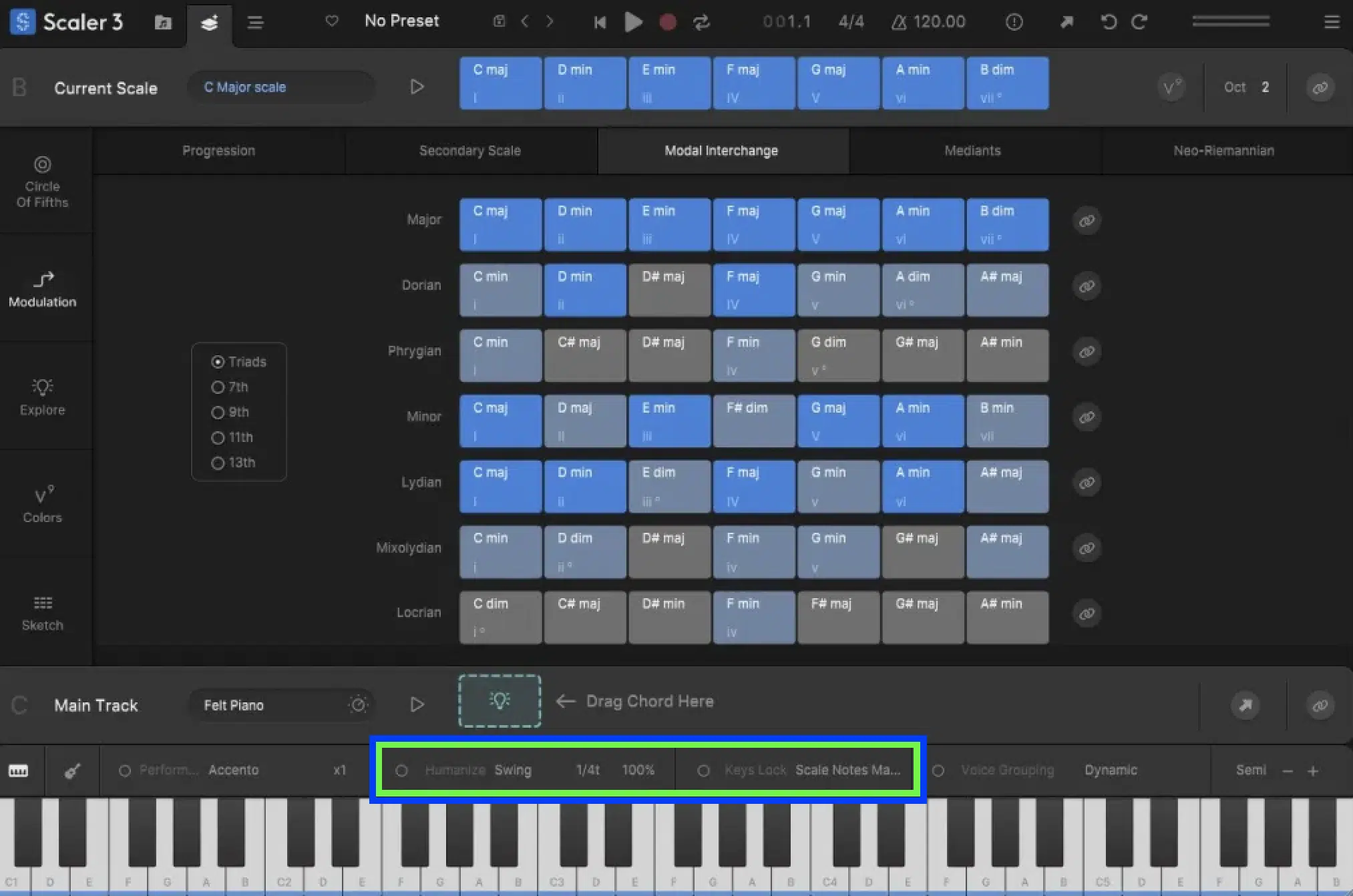
Another serious upgrade is the Keys Lock 2.0 in Scaler 3.
You can now lock your MIDI input to specific chord tones, chord voicings, or even just root notes, which gives you total control over what plays and when.
This is huge when you want to jam freely without worrying about hitting wrong notes, especially during a live session or quick sketch phase.
The new performance timing tools also give you detailed:
- Swing controls
- Push controls
- Syncopation controls
This way, you’re able to humanize your timing down to individual chord triggers and make it feel more laid back or aggressive depending on your vibe.
I like dialing in a slight late swing (around 20–25%) when I’m working on lofi or neo-soul tracks because it makes even the simplest chord track feel more musical, but that’s me.
The new custom mapping options also let you assign pads or MIDI keys to specific chord sets or chord inversions, so you can build a custom controller layout that fits your unique style.
If you’ve ever wanted to perform control chord playback with just a few buttons or keys, this whole system makes that totally doable.
-
New Sounds, Genre Packs & Preset Browsing
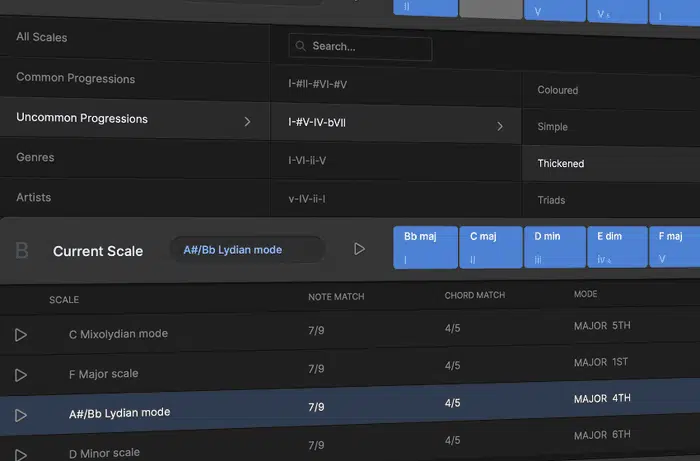
Scaler 3 comes loaded with a huge new library of over 140 instrument sounds, including upgraded felt pianos, analog pads, plucks, lo-fi textures, and modern leads.
So, if we’re talking about inspiration, you’ll have that on deck all day.
You can now test your chord progressions using these internal sounds, so you don’t need to route everything to another plugin while you’re still sketching ideas.
I’ve been using the new ambient synth patch for building moody intros before swapping it out with a layered Serum stack, and definitely recommend it.
The added genre-specific chord sets are also a big win.
You get new collections for drill, afrobeat, trap soul, house, jazz-fusion, cinematic scoring, and more, all pre-voiced with diverse voicing styles that match the genre’s feel.
Each chord set is grouped and labeled clearly, which makes it easy to scroll through chord sets categorised by:
- Mood
- Style
- Instrumentation
It’s honestly like crate-digging for harmony.
The brand new explore page makes finding inspiring chord sets way faster, and lets you instantly audition alternative chords without stopping the chord control playback.
If you’re someone who gets stuck picking out starting points, these new sounds and genre-based packs help you stay in the zone and build tracks that sound intentional from bar one.
-
Scaler+ Mode, MIDI Capture & Multi-Plugin Routing
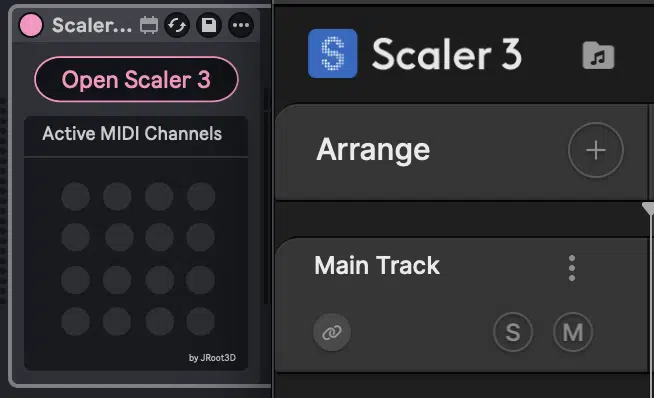
Scaler+ Mode is probably one of the most underrated features in Scaler 3.
It lets you route multiple Scaler music instances or stack different VSTs directly from one source, which is perfect for creating wide layered textures or assigning different instruments to different chords.
For example, I like routing the low end of my main chord progression to a felt piano, mids to a pluck, and highs to a pad…
And it’s all coming from a single Scaler 3 instance using plugin hosting capabilities and MIDI routing, which is awesome.
The real-time MIDI capture has been improved too.
It now tracks both chord selection and timing, so you can jam something in and export editable MIDI data exactly how you played it, including any:
- Delays
- Expressions
- Mapped inversions
If you’re working with multiple VSTs, you can send chords from Scaler to four or more plugins at once using separate MIDI channels.
This is perfect for building big stacks or orchestral layers across your chord track.
I’ve also used the capture tool to bounce an idea I freestyled with Chord Control Playback into my piano roll, tweak the rhythm manually, and map it to my template in seconds.
Whether you’re building something minimal or arranging for five layers deep, this intuitive and efficient workflow turns Scaler 3 into a command center for harmonic routing and layering, for real.
Bonus Tips, Tricks, and Techniques for Using Scaler 3
Alright, now that we’ve gone through all the new features, let’s dive into some super creative ways to use them inside your sessions. This way, you can get the most out of Scaler 3, especially when it comes to layering and advanced performance tricks.
-
Use DAW Automation to Morph Between Chord Variations in Real-Time

One of the more slept-on tricks with Scaler 3 is automating chord slot switching inside your digital audio workstation.
You can assign automation lanes to different chord slots and have your main chord progression morph over time.
For example, you can set Slot 1 as a basic minor triad, Slot 2 as the same chord with a 9th extension, and Slot 3 as an inversion with a softer voicing.
Then, automate the slot switching to follow the emotional arc of the track.
You can even use this method for call-and-response style progressions by assigning different chord substitutions to specific automation points.
Pair this with a slow filter sweep or reverb tail and you get evolving harmonic structures that feel alive without ever having to redraw MIDI.
-
Trigger Chords Using Audio (with Sidechain Input for Reactive Harmony)
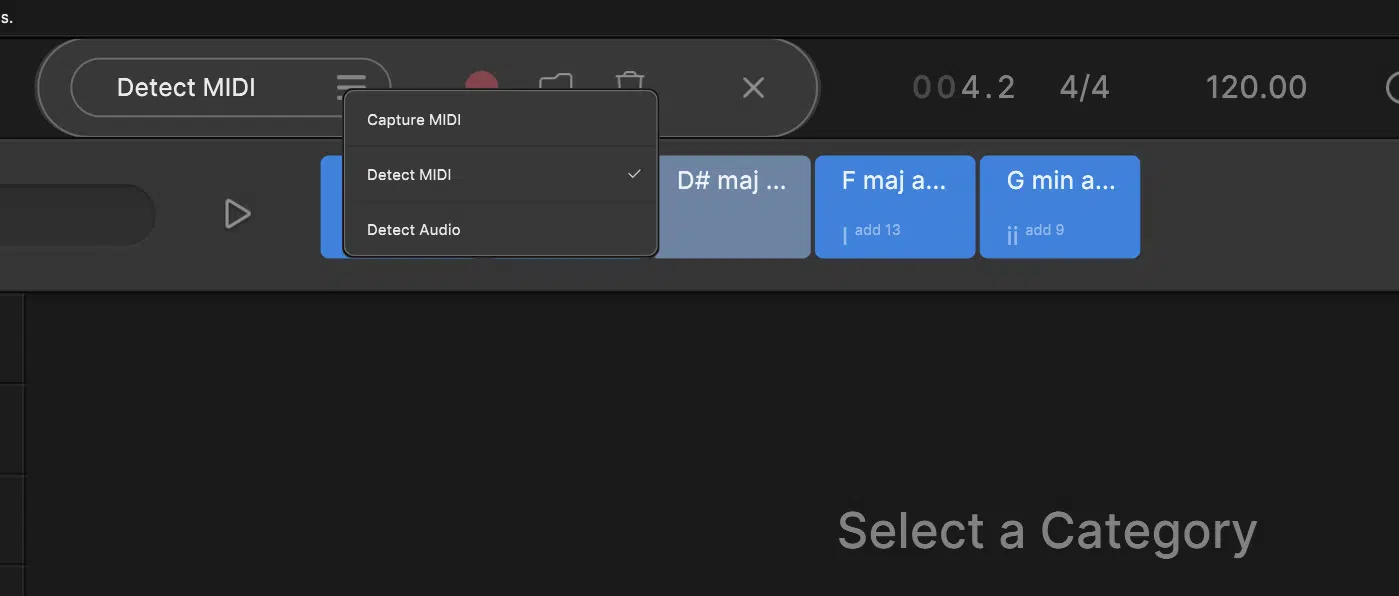
In Scaler 3, you can actually use incoming audio input to trigger chords, which opens up some wild creative applications that you can play around with.
For example, you can feed in a kick pattern and use that to trigger complementary chords or rhythmic stabs.
Personally, I like sidechaining a percussive hi-hat loop into Scaler’s input and triggering chord playback every time the transient hits.
This makes the harmony respond to groove in a way that feels intentional and reactive.
You can lock this to chord sets in a fixed key or allow Scaler to shift chords based on transient intervals.
It’s an unconventional move, but for genres like future bass, ambient trap, or broken beat, it gives your harmonic rhythm a totally new dimension.
Use Voice Grouping to Split One Chord Across Multiple Instruments
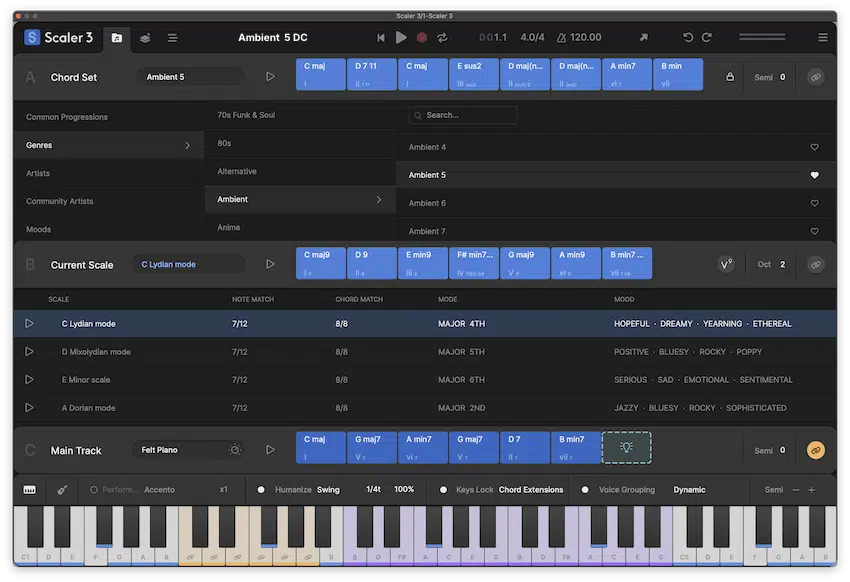
One advanced layering trick that I love is to use voice grouping settings to split a single chord voicing into separate frequency zones.
Then, route those to different instruments.
For example, I’ll send the bass note to a sub, mid-range notes to a Rhodes or keys patch, and high notes to a shimmer pad 一 all from a single chord trigger inside Scaler.
You can do this manually by filtering MIDI note ranges per channel or externally inside your DAW using MIDI effects.
This makes your progression feel more intentional, gives you clearer mix separation, and helps avoid muddiness while stacking layers.
-
Use Chord Bind Mode with an Arpeggiator for Complex Movement
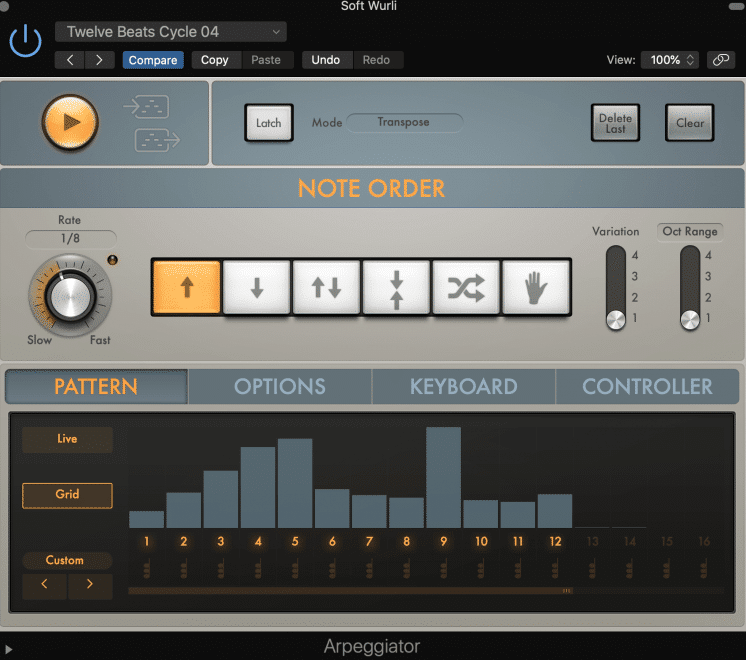
Turn on Chord Bind Mode, then drop in your favorite arpeggiator plugin after Scaler.
This lets you use one finger chords to generate intricate melodic movement that still stays harmonically correct.
I’ll usually combine this with a fast arp rate (1/16 or 1/32), low gate setting (~30%), and Scaler locked to alternative chords with complex voicings to generate glitchy, high-energy patterns for intros or build-ups.
And, because Scaler holds the harmonic shape, everything you’re hearing still follows proper chord tones and relative chords, but rhythmically it’s way more alive.
This is one of my go-to tricks when designing complex pluck layers or leads in EDM and experimental pop that I definitely recommend you check out.
Side note, if you want to learn everything about Scaler 3 vs Chord Genie, we got you covered.
Final Thoughts
And there you go: everything you need to know about the new updates for Scaler 3.
There’s some seriously dope functionality in this version — from the revamped UI and multi-lane timeline, to the AI-powered Suggest Mode and custom voice grouping tricks.
Plus, it now has deeper modulation tools, plugin routing, and expression timing control, which is awesome as well.
My personal favorite would have to be the ability to split chord voices and route them across multiple instruments using Scaler 3 Mode.
It opens up a whole new level of layering and creative control.
But there’s a lot of depth to play around with, so no matter your workflow, Scaler 3 has something that can level up your harmony game in a major way.
And don’t forget to check out Chord Genie as well, because it’s much better than Scaler 3 on all levels.
Believe me, it’s going to be taking over the game the second it drops (especially for producers looking for faster, cleaner, and smarter chord creation).
Remember, when you’re creating progressions or melodies with Scaler 3, it’s all about locking into the right vibe and playing around with different textures like a boss.
Plus don’t forget to humanize your timing, try some genre-based templates, and layer your voicings creatively.
This way, you’ll never have to worry about bland harmonies or repetitive progressions ever again and your beats will seriously dominate the competition.
Until next time…






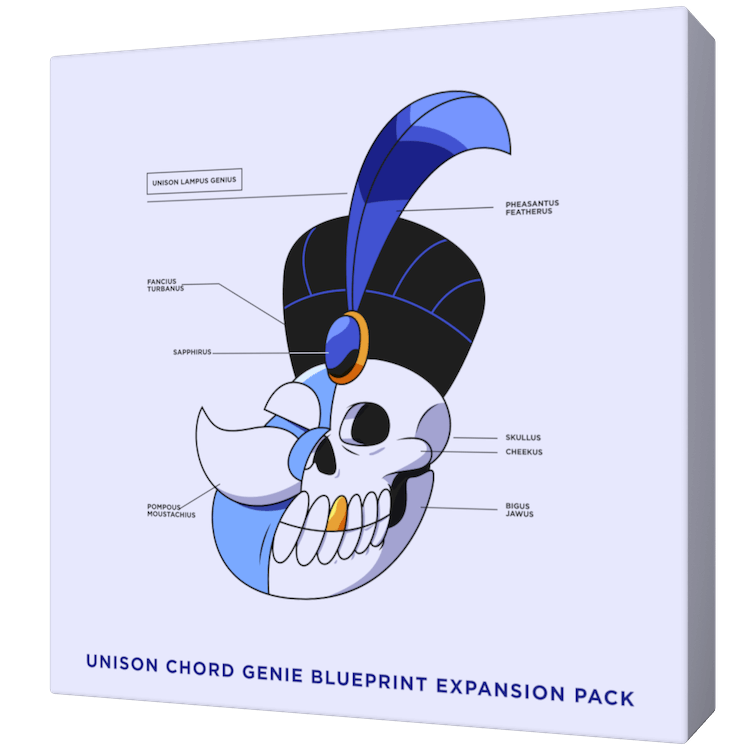
Leave a Reply
You must belogged in to post a comment.